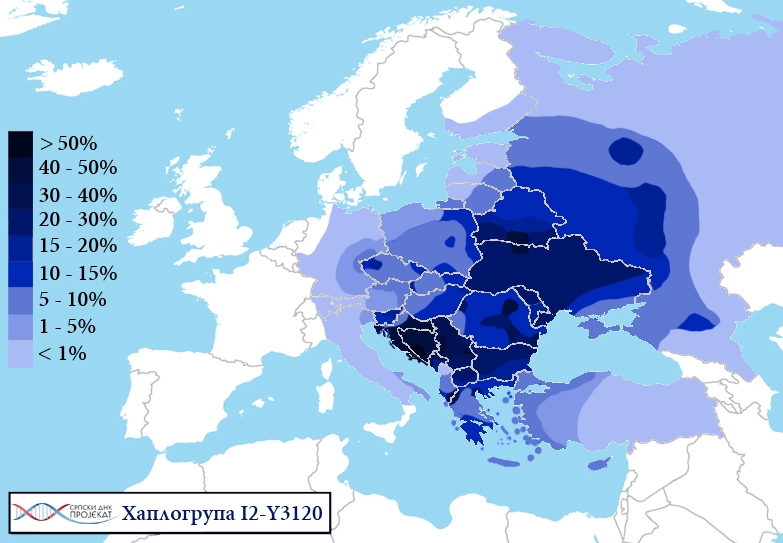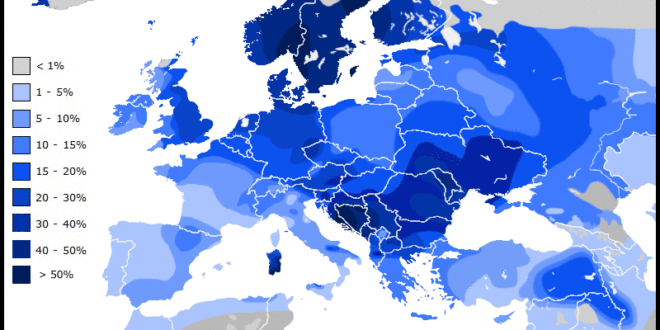Haplogroup J2, Thracians, Illyrians, Phrygians, Vlachs and others
URL:
https://www.eupedia.com/forum/threa...acians-Illyrians-Phrygians-Vlachs-and-others?
1) "Cruciani et al.’s E-V13 and J2-M12 coalescence times bear a striking similarity to carbon-14-based date calculations for certain archaeological sites in the Maritsa river valley and its tributaries, near the city of Nova Zagora, Bulgaria (Nilolova, 2002). These sites are associated directly with the proto-Thracian culture of the southern Balkans that came to dominate the region during the first millennium BCE. Sites surveyed included Ezero, Yunatsite, Dubene-Sarovka and Plovdiv-Nebet Tepe, all of which had deep associations with the developing EBA proto-Thracian culture of the region."
Haplogroup E3b1a2 as a Possible Indicator of Settlement in Roman Britain by Soldiers of Balkan Origin:
http://www.jogg.info/pages/32/bird.htm
"The invasion of Britain by the Roman military in CE 43, and the subsequent occupation of Britain for nearly four centuries, brought thousands of soldiers from the Balkan peninsula to Britain as part of auxiliary units and as regular legionnaires. The presence of Haplogroup E3b1a-M78 among the male populations of present-day Wales, England and Scotland, and its nearly complete absence among the modern male population of Ireland, provide a potential genetic indicator of settlement during the 1st through 4th Centuries CE by Roman soldiers from the Balkan peninsula and their male Romano-British descendants. Haplotype data from several major genetic surveys of Britain and Ireland are examined, analyzed and correlated with historical, epigraphic and archaeological information, with the goal of identifying any significant phylogeographic associations between E3b1a-M78 and those known Romano-British settlements and military posts that were associated specifically with Roman soldiers of Balkan origin. Studies by Cruciani et al. (2007), Perečić et al. (2005), and Marjanovic et al. (2005), examining the distribution of E3b1a-M78 and E3b1a2-V13 in the Balkans, are analyzed further to provide evidence of phylogeographic associations between the E3b1a2 haplotypes identified within the Balkans by these studies and those regions of the Balkans occupied first by the Roman army in antiquity. E3b1a2 is found to be at its highest frequency worldwide in the geographic region corresponding closely to the ancient Roman province of Moesia Superior, a region that today encompasses Kosovo, southern Serbia, northern Macedonia and extreme northwestern Bulgaria. The Balkan studies also provide evidence to support the use of E3b1a-M78 (in the present study) as a close proxy for the presence of E3b1a2-V13 (representing 85% of the parent E3b1a-M78 clade) in both the Balkans and in Britain."
2) "Research conducted by the administrators of the Border Reivers DNA Project has identified numerous haplotypes in persons of British descent that show Haplotype 35 markers. Moreover, most of these haplotypes appear to originate from areas of Britain near the Antonine Wall, Hadrian's Wall and other places of Roman fortification or settlement. These areas include Galloway, Dumfries, Ayrshire and The Borders in Scotland, and Cumbria, Yorkshire, Lancashire, Shropshire and Staffordshire in England. Many of the Roman troops stationed in these areas came from Southeastern Europe or Western Asia. They included Sarmatians, Dacians, Goths, Syrians, Mesopotamians, Thracians and Anatolians."
Elliot (And border receivers) DNA Project (Haplogroup J2) - Haplogroup R1b (Haplotype 35).
URL:
https://www.eupedia.com/forum/threa...acians-Illyrians-Phrygians-Vlachs-and-others?
1) "Cruciani et al.’s E-V13 and J2-M12 coalescence times bear a striking similarity to carbon-14-based date calculations for certain archaeological sites in the Maritsa river valley and its tributaries, near the city of Nova Zagora, Bulgaria (Nilolova, 2002). These sites are associated directly with the proto-Thracian culture of the southern Balkans that came to dominate the region during the first millennium BCE. Sites surveyed included Ezero, Yunatsite, Dubene-Sarovka and Plovdiv-Nebet Tepe, all of which had deep associations with the developing EBA proto-Thracian culture of the region."
Haplogroup E3b1a2 as a Possible Indicator of Settlement in Roman Britain by Soldiers of Balkan Origin:
http://www.jogg.info/pages/32/bird.htm
"The invasion of Britain by the Roman military in CE 43, and the subsequent occupation of Britain for nearly four centuries, brought thousands of soldiers from the Balkan peninsula to Britain as part of auxiliary units and as regular legionnaires. The presence of Haplogroup E3b1a-M78 among the male populations of present-day Wales, England and Scotland, and its nearly complete absence among the modern male population of Ireland, provide a potential genetic indicator of settlement during the 1st through 4th Centuries CE by Roman soldiers from the Balkan peninsula and their male Romano-British descendants. Haplotype data from several major genetic surveys of Britain and Ireland are examined, analyzed and correlated with historical, epigraphic and archaeological information, with the goal of identifying any significant phylogeographic associations between E3b1a-M78 and those known Romano-British settlements and military posts that were associated specifically with Roman soldiers of Balkan origin. Studies by Cruciani et al. (2007), Perečić et al. (2005), and Marjanovic et al. (2005), examining the distribution of E3b1a-M78 and E3b1a2-V13 in the Balkans, are analyzed further to provide evidence of phylogeographic associations between the E3b1a2 haplotypes identified within the Balkans by these studies and those regions of the Balkans occupied first by the Roman army in antiquity. E3b1a2 is found to be at its highest frequency worldwide in the geographic region corresponding closely to the ancient Roman province of Moesia Superior, a region that today encompasses Kosovo, southern Serbia, northern Macedonia and extreme northwestern Bulgaria. The Balkan studies also provide evidence to support the use of E3b1a-M78 (in the present study) as a close proxy for the presence of E3b1a2-V13 (representing 85% of the parent E3b1a-M78 clade) in both the Balkans and in Britain."
2) "Research conducted by the administrators of the Border Reivers DNA Project has identified numerous haplotypes in persons of British descent that show Haplotype 35 markers. Moreover, most of these haplotypes appear to originate from areas of Britain near the Antonine Wall, Hadrian's Wall and other places of Roman fortification or settlement. These areas include Galloway, Dumfries, Ayrshire and The Borders in Scotland, and Cumbria, Yorkshire, Lancashire, Shropshire and Staffordshire in England. Many of the Roman troops stationed in these areas came from Southeastern Europe or Western Asia. They included Sarmatians, Dacians, Goths, Syrians, Mesopotamians, Thracians and Anatolians."
Elliot (And border receivers) DNA Project (Haplogroup J2) - Haplogroup R1b (Haplotype 35).








